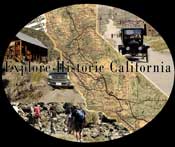Early in May 2014 strings of mules and their human companions
could be seen traversing the Inyo Mountains on a survey which
included a search for water and grazing areas to sustain such
endeavors. Mules have been an important part of the history of
this rugged area tucked between Owens Valley and the modern
boundaries of Death Valley National Park. The mule’s ability to
traverse over precipitous mountains with peaks ranging as high
as 11,000 feet, while carrying large weights of supplies, tools
and machinery, made them the equine of choice for mid-19th
century Argonauts in search of mineral wealth.
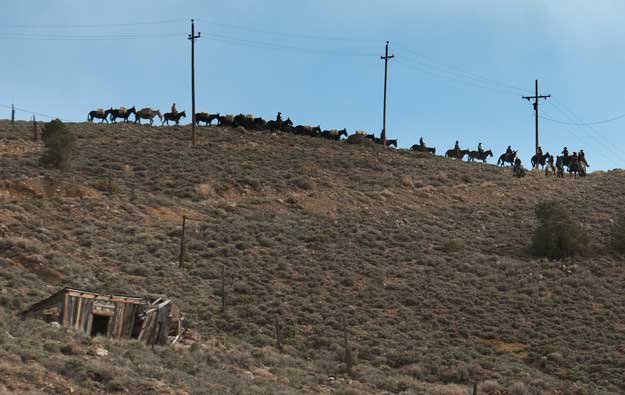 |
|
A train
of mules works their way down hill into Cerro Gordo
during part of an Inyo Mountains exploring and
mapping trip organized by Metabolic Studio in Los
Angeles. |
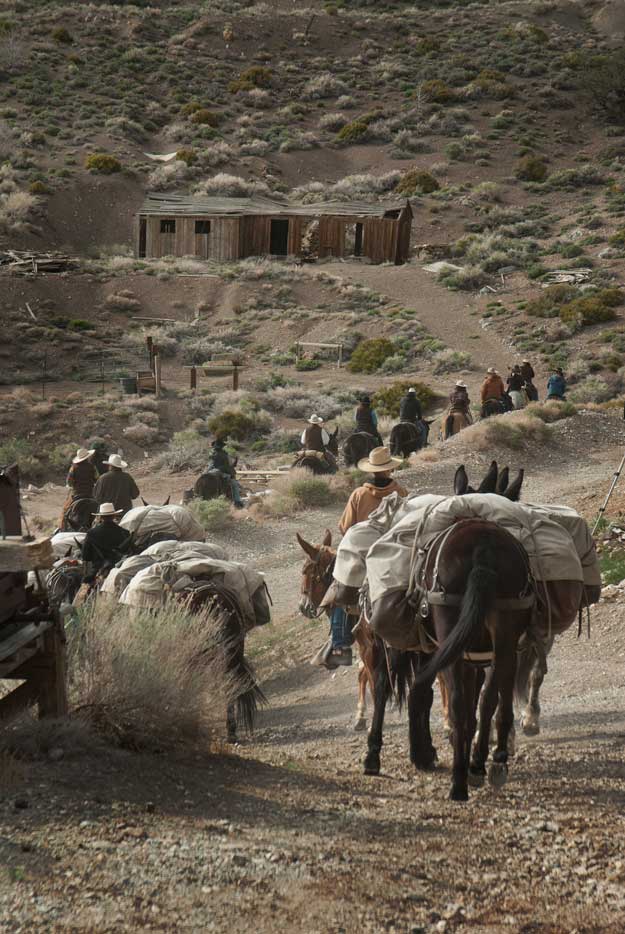 |
Today, mules and horses enable visitors to explore the rugged
backcountry in search of outdoor recreation in the trails,
meadows rivers and lakes of the Sierras.
The mule was created as early as 3000 BC when man discovered
breeding a female horse and a male donkey would create an animal
with the height, appetite, uniformity of coat, neck and rump the
shape of a horse, but short wide head, thick mane, long ears,
thin legs, and small hoofs of a donkey. The mule was trainable
through voice command and showed the ability to respond to a
rider or packer’s emotions with a good sense of direction even
in the dark of night like the horse.
From the donkey, the mule inherited the ability to refuse
anything that might hurt him or his load. All in all the mule
became known as a more patient, surefooted, hardy and long lived
than a horse, as well as less obstinate, faster and more
intelligent than the donkey, and possessing the traits that are
perfect for pack train travel in the mountain
The Spanish realized the valuable skills of the animals, as
they came over by ship to North America, mules in tow. The mule
proved itself during explorations of the varied landscape of the
American west. If an area was not reachable easily by pack
train, settlement would more than likely not be attainable.
Pack trains of trappers, explorers and emigrants followed the
Spanish with horses, mules, and donkeys the common transporters
in the California foothills and valleys. The communities that
cropped up around the primitive trail system quickly realized
that the pack train was crucial to their survival, often the
only way to bring in supplies. The American military began
using the roads and pack trails for mapping and scientific
expeditions as well as military conquests which subsequently
gained the Golden State entry into the United States.
The gold rush of 1848-1870 brought in more emigrants in search
of riches. As they settled and became established citizens of
California, recreational use of the High Sierras became popular.
By 1870, families were looking for refuge from the valley heat
and trekked to the old mining and lumbering camp resorts.
Ranchers provided pack trains for them to go on adventures which
included exploration of sheep, cattle, mining and Indian
trails. Mountaineers, hunters, fisherman, nature enthusiasts
and other adventurers soon took to the rough mule trails and the
modern packing industry was born. Packers for commercial mining
operations began including summer pack trips into the Sierra.
National Parks and mule packing grew up around each other, with
mules often being the only wait to access and navigate protected
areas before appropriate wagon trails would be built. John Muir
hired a packer out of Visalia Big Tree Grove (now General Grant
Grove) to “manage packs”. Commercial pack outfits and private
concessionaires began not only to lead back country trips, but
to help develop and maintain the roads. By the 1900’s these
outfits were supporting government projects involving fire
suppression and trail and bridge construction and maintenance.
They also aided in construction and hauling supplies for ranger
stations and railroads to be built. Government surveying parties
relied on packers and mules to haul supplies. Water and Power
companies took advantage of packing services to search for
hydroelectric plant and reservoir sites, then haul in equipment
and supplies for building. Packers also were implemented to
carry fish fry to stock rivers and lakes in remote areas.
|
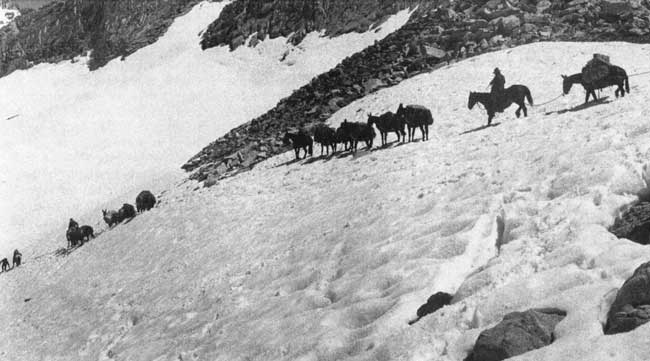 |
|
Ansel Adams photographed a pack train crossing Black
Rock Pass in Sequoia National Park in 1934
during a Sierra Club "High Trip". Adams was
Sierra Club member and a frequent traveler on the
year excursions. |
Between 1902 and 1942 the Sierra Club would hire packers for
groups as large as 100 or more. A 1903 trip to Mount Whitney
outfitted by Broder and Hopping required the service of 85 mules
and saddle animals. Thirty thousand pounds of personal baggage,
provisions and camp equipment needed to be hauled, as well as
many of the participants. The trips were annual, and often
fraught with problems. A snow packed trail would take from dawn
to well past midday to get 110 mules past it. As snows melted
high water would create dangerous stream crossings. Mules would
slide off trails. Rockfalls, washouts, destroyed bridges,
tangled undergrowth and downed timber created more hazards and
obstacles, in spite of efforts to make the trail safe.
Recreational trip packers were in charge of participants comfort
and happiness. They provided and packed the food, the equipment
and the cook and crew to prepare it. Canvas tents, tables,
chairs, equipment, horse and mules shoes and more added to the
poundage on the pack of the mules which could be anywhere from
175 to 250 pounds. The Sierra club trips brought more
recreational interest as the 1920’s were approached. The wealthy
would arrange large parties for family, friends, and employees
that would last for nearly a month. Services ranged from
furnished equipment to guides and cooks. Some required guide
service and some only asked for delivery and retrieval to and
from backcountry camp sites.
 |
|
Mule
power continued to be used for construction into the
twentieth century. Mule teams provided more
reliable motive force then the early Caterpillar
"traction engines" during construction of the Los
Angeles Aqueduct (top photo). Mules ability to
haul heavy loads up steep grades was utilized to
haul a boiler up the Yellow Grade Road to Cerro
Gordo in the early 1900's (bottom photo). |
|
 |
In addition to offering trips for enjoyment, packers began
supplementing their income by hauling and providing day rides.
Stock was lent out for parades and rodeos. Hollywood took
advantage of the services and hired packers to handle stock and
supplies for movie making in the Sierras and Owens Valley. By
1950 tightened rules and regulations and backpacking, brought
hard times. Several outfitters took advantage of the popularity
of the show business image of the “old west”. Black Stetsons,
heavy chaps, clean shirts, handle bar mustaches, western drawls
and tight lipped smiles became the look of the mule packer.
Trips would include campfire tales and entertainment. Old timer
mule packers complained, “Today things are different. There are
too few stations and too many operators I call candlestick
makers…They’ll buy a pair of fancy boots and a great big
sombrero and without knowing which end a mule feeds, they are
supposed to be packers.” With the arrival of the 1970’s
comfortable packing trips led by pseudo-cowpokes was where the
money was.
Today pack and saddle stock is still recognized as traditional
and historically significant activity for backcountry enjoyment,
in spite of conservation and environmental concerns, and
increased costs. Travelers are often looking for short and
varied excursions throughout the year, and have many more
destinations and opportunities available to them other
experiencing an old fashioned mule ride. Up and down the Sierra
Nevadas and Owens Valley commercial packers still exist for
those wishing to partake. In addition to the pack trips in the
backcountry, hour or day rides, long retreats, wagon rides,
weddings, bbq’s, animal renting for film industry and weddings,
and more are amongst the services offered by many of the
packers.
|
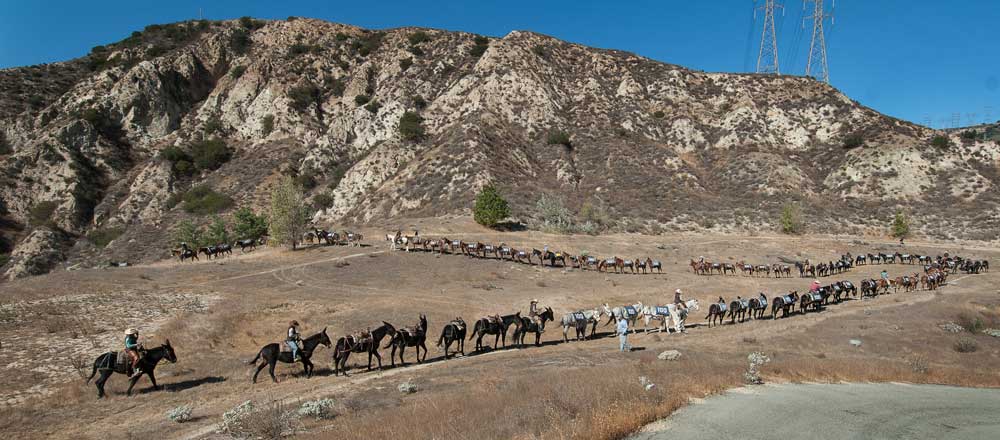 |
|
"100 Mules Walking the Los Angeles Aqueduct"
celebrated the centennial of the Los Angeles
Aqueduct from Owens Valley to Los Angeles in
November, 2013. The walk was both an art project and
historic celebration organized by Metabolic Studio.
In the photo above, the mules gather in a clearing
above the rededication ceremony at the terminus of
the aqueduct near the intersection of Interstate 5
and Highway 14 in Sylmar, Calif. |
The barren desert environment of the White and Inyo Mountains to
the east of the Sierra Nevada prohibits all but a few packers
from offering any kind of recreational use, except for hunting.
Some ranchers are known to have grazing allotments with younger
cows relying on the older one’s who know the country and can
lead them to the rare resources available. The history of
packing and freighting with mules leads us primarily to the
mining industry and that same drive for wealth no matter what
physical obstacle one has to endure to get to them that the
early 49’ers had.
Nadeau, Olivas, Dixon, Spear, Hunter, Carrasco, Skinner and
Arculus are a few of the names associated with the packing or
freighting of groceries, lumber, machinery, explosives, water
and ore to and from the mining camps the likes of Beveridge,
Keynot, McElvoy Canon, Cerro Gordo, Burgess, Hunter Canyon,
Bunker Hill. The water was so scarce in some instances the
mules barely returned alive. The party of mules re-tracing some
of the same trails in May of 2014 had the advantage of modern
four wheel drive vehicle to cache large amounts of water and
feed along the way.
Read more about the history of the mule:
American Mule Museum:
http://mulemuseum.org/History_of_the_Mule.html
University of Missouri Mule Club:
http://www.cvm.missouri.edu/org/muleclub/facts.html
Eastern Sierra Packers:
http://www.easternsierrapackers.com/
Western High Sierra Packers Association:
http://www.highsierrapackers.org/packers.html
100 Mules Walking the Los Angeles
Aqueduct:
http://www.kcet.org/shows/artbound/100-mules-walking-the-los-angeles-aqueduct.html

